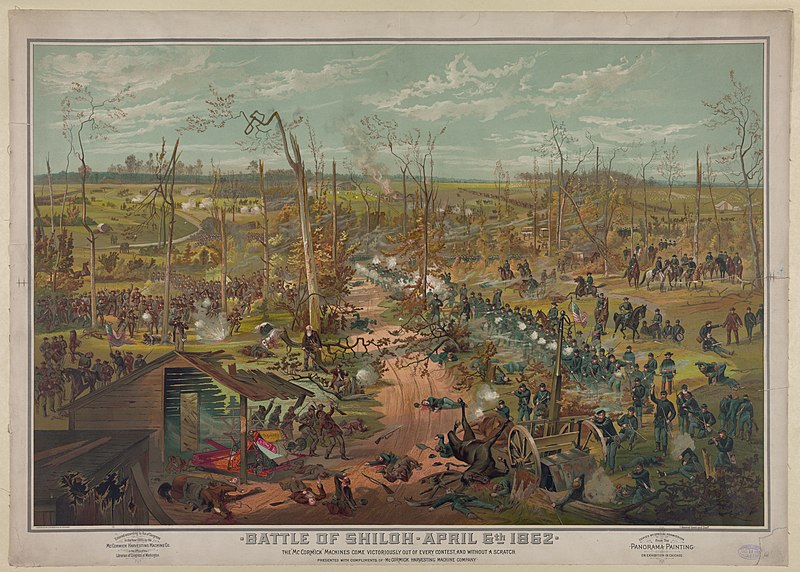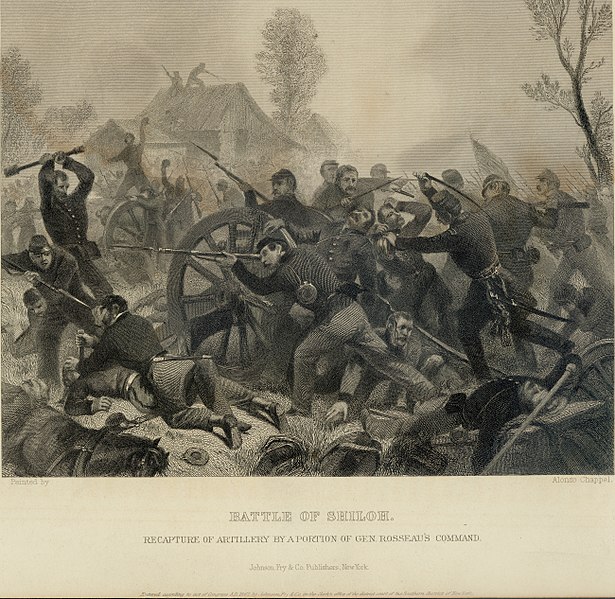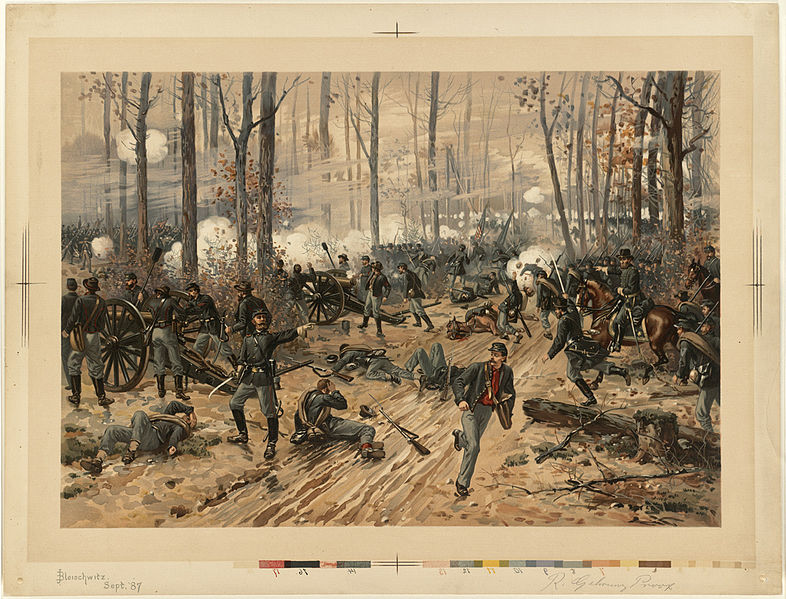The Battle of Shiloh, also known as the Battle of Pittsburg Landing, was fought on April 6 and 7, 1862, in Tennessee during the American Civil War.
It was the first major battle in the Western Theater of the Civil War, and it resulted in a Union victory.
The battle was fought between the Confederate Army of Mississippi, led by General Albert Sidney Johnston, and the Union Army of the Tennessee, led by General Ulysses S. Grant.
| Statistic | Details |
|---|---|
| Dates | April 6-7, 1862 |
| Location | Near Pittsburg Landing, Tennessee, along the Tennessee River |
| Commanders | |
| – Union | Major General Ulysses S. Grant and Major General Don Carlos Buell |
| – Confederate | General Albert Sidney Johnston and General P.G.T. Beauregard |
| Forces Involved | |
| – Union | Around 63,000 troops |
| – Confederate | Approximately 40,000-44,000 troops |
| Casualties | |
| – Union | Approximately 13,000 (killed, wounded, missing/captured) |
| – Confederate | Approximately 10,000 (killed, wounded, missing/captured) |
| Outcome | The battle was technically inconclusive, but strategically it was a Union victory. |
| Significance | The Battle of Shiloh was one of the bloodiest battles of the Civil War up to that point and demonstrated the enormous human cost of the conflict. It also marked a turning point in the war. |
Battle of Shiloh Facts
1. First Battle in Which Grant Used the “Anaconda Plan
The Battle of Shiloh was the first battle of the civil war in which Grant used the “Anaconda Plan,” a strategy for defeating the Confederacy by blockading its ports and dividing it into smaller pieces, cutting off its access to foreign trade and supplies, and forcing it to surrender through economic and military pressure.
Also Read: Battle of Shiloh Timeline
The plan called for the Union Navy to blockade the Southern coast and establish a naval blockade to prevent the Confederacy from importing goods and exporting cotton, which was a major source of revenue for the South.
The Anaconda Plan was never fully implemented, as the Union focused more on direct military action rather than economic and naval blockade.
Also Read: Facts About the Battle of Fort Sumter
However, the blockade of Southern ports did play a significant role in the Union’s ultimate victory, as it disrupted the Confederacy’s economy and made it more difficult for the South to obtain the resources it needed to continue fighting.

2. The Union Army was Caught Off Guard
At the start of the battle, the Union army, led by Generals Ulysses S. Grant and Don Carlos Buell, was caught off guard by a surprise attack launched by the Confederate army, led by Generals Albert Sidney Johnston and P.G.T. Beauregard.
Also Read: Timeline of the Battle of Antietam
The Confederates initially made significant gains and pushed the Union army back to the Tennessee River. However, the Union army was able to regroup and launch a counterattack, eventually driving the Confederates back and securing a victory.
3. One of the Bloodiest Battles of the Civil War
The Battle of Shiloh was one of the bloodiest battles of the Civil War, with over 23,000 total casualties.
The high number of casualties at Shiloh was due in part to the close quarters of the fighting and the use of artillery, which caused widespread destruction and loss of life.
Also Read: Facts About the Battle of Antietam
The battle was also significant for the high number of casualties suffered by both sides, as it demonstrated the deadly nature of the Civil War and the high human cost of the conflict.
4. Confederate Commander, General Albert Sidney Johnston, was killed in the Battle
Confederate commander, General Albert Sidney Johnston, was killed in the Battle of Shiloh on April 6, 1862. His death was a significant blow to the Confederacy, as he was one of the South’s most capable and experienced commanders.
Johnston had led the Confederate attack on the Union army at the start of the battle and had initially achieved some success, pushing the Union army back to the Tennessee River.
However, as the battle raged on, Johnston was shot in the leg and bled to death. His death disrupted the Confederate command structure and may have contributed to the eventual Union victory at Shiloh.
5. Marked the Beginning of Grant’s Rise to Prominence as a Union commander
General Ulysses S. Grant was criticized for his handling of the Battle of Shiloh, however, despite this criticism, Grant went on to become a key figure in the Civil War and the overall commander of the Union army.
Grant faced criticism for his handling of the battle, as he was accused of being unprepared and allowing the Confederates to gain the upper hand.
However, he was able to learn from his mistakes and go on to achieve great success in the Civil War, including the capture of Vicksburg and the defeat of Confederate General Robert E. Lee at the Battle of Appomattox, which effectively ended the war. Grant later went on to become the 18th President of the United States.

6. Victory at Shiloh Encouraged the Lincoln Administration to Pursue More Aggressive Tactics
The Union victory at Shiloh demonstrated the Union’s ability to recover from a defeat and go on to win a major battle, which may have encouraged the Lincoln administration to pursue more aggressive tactics in the war.
This could include expanding the Union’s military efforts and adopting more aggressive strategies to defeat the Confederacy.
However, it is important to note that the decision-making process during the Civil War was complex and involved a wide range of factors, including political, military, and economic considerations. The Union’s victory at Shiloh was just one of many events that influenced the course of the war.
7. It is Now a National Park
The battlefield is now a national military park, and it is home to the Shiloh National Cemetery, which is the final resting place for many of the soldiers who fought in the battle.
The battlefield is also home to the Shiloh Church, which served as a makeshift hospital during the battle and is now a museum.
8. First Use of the Parrot Gun
Union army used a new type of artillery called the “Parrott gun” during the Battle of Shiloh. The Parrott gun was a type of rifled artillery developed by Robert Parker Parrott, a Union army officer and inventor.
It was made of cast iron and used a hollow breech to allow for greater accuracy and longer range than other artillery pieces of the time.
The Parrott gun was used by the Union army during the Civil War to support its operations on land and at sea. It was particularly effective in naval warfare, as it had a longer range and greater accuracy than other artillery pieces.
9. The Union Soldiers Were Inexperienced
The Battle of Shiloh was the first major engagement for many of the Union soldiers who participated in the battle. The Union army was made up of a mix of experienced soldiers and green, inexperienced troops, and the Battle of Shiloh was the first major test for many of these soldiers.
10. Weapons Were in Short Supply
Flintlocks, shotguns, squirrel rifles, and percussion muskets were some of the types of small weaponry that were available.
Before the conflict, a few thousand of the incredibly accurate Enfield rifles were sent out to Johnston’s forces.
When they were taken from Union troops throughout the conflict, the Confederate army’s supply of Enfield rifles expanded significantly.
At the beginning of the conflict, just one-third of the cavalry had any kind of weapon with them.
It was significantly easier for Johnston to determine the positions of both Union armies because to the superior performance of the Confederate cavalry compared to their Union counterparts.
